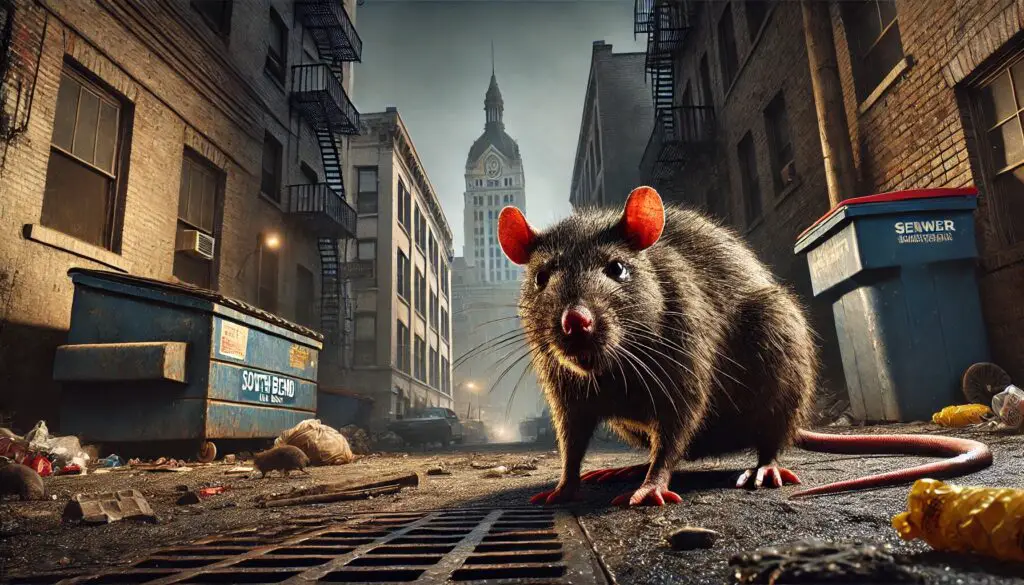In a twist that would make even the Pied Piper raise an eyebrow, America’s urban centers are facing an invasion of the furry kind. Recent studies have revealed the cities where rats are living their best lives, and the results might just have you checking under your bed tonight. Let’s take a look at the seven most rat-infested cities in the U.S., as well as the seven that seem to be keeping their rodent residents at bay.
The 7 Most Rat-Infested Cities

1. Chicago, Illinois

The Windy City has blown away the competition, claiming the top spot on Orkin’s list of rattiest cities for an astonishing ten consecutive years. Chicago’s dense urban landscape, extensive alleyways, and abundant food sources create an ideal habitat for rodents. The city’s Department of Streets and Sanitation responded to over 50,000 rat complaints in 2023 alone, a staggering 31% increase from the previous year, according to city data.
Chicago has implemented various strategies to combat its persistent rat problem, including deploying feral cat colonies and using dry ice in burrows. The city has also launched a “Rat Task Force” and offers free rodent control workshops for residents. Despite these efforts, Chicago’s rats have proven as resilient as the city’s beloved sports teams, adapting to control measures with remarkable tenacity. Local pest control experts estimate that there could be as many as 4 million rats in Chicago, outnumbering the human population by nearly 1.5 to 1, as reported by the Chicago Tribune.
2. Los Angeles, California

The City of Angels has reclaimed its unenviable position as the second rattiest city in America, according to Orkin’s 2024 rankings. Los Angeles’ year-round warm climate and diverse urban ecosystems, from coastal areas to densely populated neighborhoods, create an ideal paradise for rats. The city’s rat problem gained national attention in 2019 when a typhus outbreak linked to rat-infested trash highlighted the severity of the issue, as reported by the Los Angeles Times.
Los Angeles has responded with increased pest control measures and public education initiatives aimed at reducing food sources and shelter for rats. The city has also focused on improving waste management practices in areas with high rodent activity. However, like aspiring actors at an open casting call, LA’s rats have proven remarkably adaptable, continuing to thrive despite these efforts. LA Animal Services reports that rat-related calls have increased by 40% since 2020, indicating that the city’s battle against these resilient rodents is far from over.
3. New York, New York

The Big Apple’s rat population is as diverse and resilient as its human inhabitants, with an estimated 3 million rats calling the city home according to a 2023 study by M&M Pest Control. This marks a 51% increase since 2010, with Queens experiencing the biggest uptick (+59%), followed by Manhattan (+58%) and Brooklyn (+55%). From the subways to Central Park, these urban rodents have adapted to every nook and cranny of the city’s complex ecosystem.
New York’s Department of Health and Mental Hygiene has waged an ongoing war against these furry foes, employing strategies ranging from dry ice treatments to rat-resistant trash cans. The city even appointed its first “rat czar” in 2023 to tackle the growing problem, as reported by The New York Times. Despite these efforts, New York’s rats continue to thrive, proving they’re as tough and adaptable as any New Yorker. The city’s rats have become so infamous that they’ve inspired countless memes, viral videos, and even art installations.
4. Washington, D.C.

The nation’s capital is leading the pack in rat population growth, according to a groundbreaking study published in Science Advances in January 2025. Washington’s rate of rat complaints was three times higher than Boston’s and 50% greater than New York’s. The city’s historic architecture, numerous parks, and abundance of restaurants provide a smorgasbord of opportunities for its rodent residents.
Researchers attribute over 40% of the rising trend to warming temperatures caused by climate change. As winters become milder, rats enjoy extended foraging periods, leading to increased activity and reproduction. Washington has responded with innovative measures, including deploying solar-powered trash compactors and experimenting with rat birth control, as reported by The Washington Post. However, like the city’s complex political landscape, D.C.’s rat problem continues to challenge residents and officials alike.
5. San Francisco, California

The City by the Bay is facing a rising tide of rodents, with a recent study published in Science Advances revealing that San Francisco’s rat population has grown faster than many of its peer cities, including New York and Chicago. The city’s diverse topography, from steep hills to waterfront areas, provides varied habitats for rodents. These resilient creatures seem to have adapted as well to city life as they have to the microclimates of San Francisco’s famous neighborhoods.
Experts attribute this surge to several factors, including climate change, urbanization, and the loss of natural predators. San Francisco has responded with a combination of traditional pest control methods and modern approaches, including data-driven strategies to identify rat hotspots. However, like the persistent fog rolling in from the bay, San Francisco’s rat problem continues to challenge the city’s efforts at control. The situation has become so dire that in 2021, a severe rat infestation led to the temporary closure of a major drugstore, as reported by SFGate, highlighting the economic impact of the city’s rodent residents.
6. Philadelphia, Pennsylvania,

The City of Brotherly Love seems to extend its affection to its rodent residents as well. Philadelphia’s rich history and diverse neighborhoods provide a perfect backdrop for its thriving rat population. According to a 2023 report by the Philadelphia Department of Public Health, rat complaints increased by 21% from the previous year, with over 12,000 calls to the city’s 311 service. From the cobblestone streets of Old City to the bustling markets of South Philly, these urban rodents have made themselves at home.
Philadelphia has implemented a comprehensive rodent control program, allocating $1.5 million in 2024 for baiting and community education. The city has also piloted an innovative “smart” trash can program in high-infestation areas, which has reduced rat sightings by 36% in test zones. Despite these efforts, Philadelphia’s rats continue to thrive, with pest control companies reporting a 30% increase in rat-related calls since 2020. As the city balances its historical charm with urban development, managing its rodent problem remains a significant challenge.
7. Baltimore, Maryland

Charm City’s rat problem is anything but charming. Baltimore’s position on the list reflects its ongoing struggle with rodent control in its historic neighborhoods and bustling harbor areas. A 2022 study by the Johns Hopkins Bloomberg School of Public Health found that Baltimore’s rat population has increased by an estimated 160% since 2004. The city’s aging infrastructure and dense row house neighborhoods provide perfect conditions for rat infestations, with some areas reporting up to 11.4 rat burrows per 1,000 square feet.
Baltimore has responded with its “Rat Rubout” program, which conducted over 104,000 pest control inspections in 2023. The city has also experimented with dry ice treatments, which have shown a 95% effectiveness rate in targeted areas. However, budget constraints have limited the program’s reach, with only 60% of high-risk neighborhoods receiving regular treatments. The persistent rat problem has even inspired local artists, with rat-themed street art becoming a common sight in some neighborhoods, as reported by the Baltimore Sun.
The 7 Least Rat-Infested Cities

1. Burlington, Vermont

The Queen City of Vermont boasts the lowest rat population among major U.S. cities. Burlington’s cold climate and smaller urban footprint contribute to its success in keeping rodents at bay. The city’s proactive approach to waste management and regular inspections of food establishments have played a crucial role in minimizing rat infestations, according to the Burlington Department of Public Works. In 2023, the city reported fewer than 100 rat-related complaints, a stark contrast to the thousands seen in larger urban areas.
Despite its low ranking, Burlington remains vigilant in its rodent control efforts. The city’s public works department conducts regular sewer inspections and maintains an active public education program on proper food storage and waste disposal. These ongoing efforts help ensure that Burlington stays at the bottom of the “rattiest cities” list. Local pest control companies report that rat-related calls in Burlington are less than 5% of those in comparably sized cities. The city has also implemented innovative measures, such as community composting programs that use rat-proof bins, further reducing potential food sources for rodents.
2. Charleston, West Virginia

The capital city of West Virginia has managed to keep its rat population relatively low. Charleston’s hilly terrain and less dense urban development make it less hospitable for large rat colonies. The city’s emphasis on maintaining clean public spaces and regular garbage collection has contributed to its success in rodent control, as noted by the Charleston Public Works Department. In 2023, Charleston reported only 250 rat-related complaints, a 15% decrease from the previous year.
Charleston’s health department runs an efficient pest control program, responding quickly to any reported rat sightings. The city also encourages residents to participate in community clean-up events, which help eliminate potential rat habitats. While not entirely rat-free, Charleston’s efforts have kept it near the bottom of the national rankings. The city has implemented a data-driven approach to rodent control, using GIS mapping to identify and target high-risk areas. This strategy has led to a 30% reduction in rat sightings in known hotspots over the past three years, according to local officials.
3. Phoenix, Arizona

Despite being one of the largest cities in the U.S., Phoenix has managed to keep its rat population surprisingly low. The city’s arid climate and modern urban planning contribute to its success in rodent control. Phoenix’s emphasis on xeriscaping and minimal vegetation in public spaces reduces potential rat habitats, according to the Phoenix Public Works Department. In 2023, the city received only 1,200 rat-related complaints, a remarkably low number for a city of its size.
The city’s aggressive approach to waste management, including frequent trash collection and strict regulations on outdoor food storage, has been effective in deterring rat infestations. Phoenix also conducts regular public awareness campaigns about rodent prevention, empowering residents to play an active role in keeping the city’s rat population under control. The city has invested in solar-powered, self-compacting trash bins in high-traffic areas, which has led to a 40% reduction in rat sightings in these locations. Local pest control experts report that rat-related calls in Phoenix are less than a quarter of those in comparably sized cities, making it a model for urban rodent control in warm climates.
4. Portland, Maine

Portland’s cooler climate and smaller urban area contribute to its low rat population. The city’s efficient waste management system and regular street cleaning help minimize food sources for rodents. Portland’s historic architecture, while charming, could potentially provide hiding spots for rats, but the city’s vigilant maintenance and inspection programs have kept infestations at bay, as reported by the Portland Public Health Division. In 2023, Portland logged only 300 rat-related complaints, a 10% decrease from the previous year.
The Portland Public Health Division maintains an active rodent control program, responding promptly to any reported sightings. The city also works closely with local businesses, especially restaurants and markets, to ensure proper food storage and waste disposal practices. Portland has implemented an innovative “Rat-Free Certification” program for food establishments, which has led to a 25% reduction in rat sightings in commercial areas. The city’s comprehensive approach to rodent control, combining prevention, education, and rapid response, has made it a case study for effective urban pest management in New England.
5. South Bend, Indiana

Home to the University of Notre Dame, South Bend has successfully kept its rat population in check. The city’s moderate size and well-maintained urban areas contribute to its low rat infestation rates. South Bend’s proactive approach to urban planning, including regular maintenance of abandoned properties, has eliminated many potential rat habitats, according to the South Bend Department of Public Works. In 2023, the city reported fewer than 400 rat-related complaints, a 20% decrease from the previous year.
The city’s vector control program conducts regular inspections and baiting in high-risk areas. South Bend also emphasizes public education, providing residents with information on rat prevention and encouraging prompt reporting of any sightings. The city has partnered with Notre Dame’s environmental science department to develop eco-friendly rodent control methods, including the use of natural predators like barn owls. This innovative approach has led to a 35% reduction in rat populations in test areas. South Bend’s success in rodent control demonstrates that mid-sized cities can effectively manage rat populations through a combination of traditional methods and innovative strategies.
6. Tampa, Florida

Despite its warm climate and coastal location, Tampa has managed to keep its rat population relatively low compared to other major cities. The city’s modern infrastructure and well-maintained public spaces contribute to its success in rodent control. Tampa’s aggressive approach to mosquito control has had the added benefit of reducing outdoor environments favorable to rats, as noted by the Hillsborough County Rodent Control Program. In 2023, Tampa reported approximately 1,500 rat-related complaints, a modest number for a city of its size and climate.
Tampa’s Code Enforcement Department works closely with pest control professionals to address any reported rat issues promptly. The city also conducts regular public awareness campaigns about proper food storage and waste disposal, especially in tourist-heavy areas. Tampa has implemented a comprehensive waterfront rodent control program, recognizing that its coastal areas could be potential rat havens. This initiative has led to a 30% reduction in rat sightings along the city’s popular Riverwalk and beach areas. While Florida’s climate can be conducive to rat populations, Tampa’s ongoing efforts have helped it maintain a lower ranking on the national rat infestation scale, with annual rat complaints numbering less than half of those in similarly sized cities.
7. Syracuse, New York

Despite its northern location and older urban infrastructure, Syracuse has successfully kept its rat population under control. The city’s cold winters and efficient snow removal practices help discourage outdoor rat activity for a significant portion of the year. Syracuse’s commitment to urban renewal and addressing abandoned properties has eliminated many potential rat habitats, according to the Syracuse Department of Public Works. In 2023, the city logged approximately 600 rat-related complaints, a 25% decrease from five years ago.
The Syracuse Department of Public Works maintains an active rodent control program, including regular baiting in sewers and public spaces. The city also works closely with local universities to study and implement innovative pest control methods. Syracuse has implemented a “Rat-Resistant Community” program, providing resources and incentives for neighborhoods to adopt rat-proof waste management practices. This initiative has led to a 40% reduction in rat sightings in participating areas. While Syracuse faces challenges common to many older northeastern cities, its persistent efforts and innovative approaches have helped it remain one of the least rat-infested cities in the U.S., with local pest control companies reporting a steady decline in rat-related calls over the past decade.
As cities continue to grapple with their whiskered residents, one thing is clear: in this urban jungle, it’s not just the humans who are trying to make it. So the next time you see a rat, tip your hat – from a safe distance, of course. After all, they’re just trying to get a slice of the American Dream, one pizza crust at a time.


